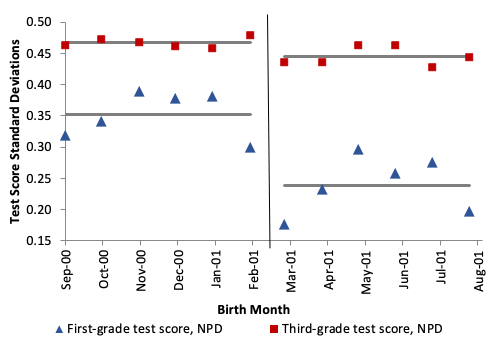In most OECD countries, primary education starts at age 6 to 7; the UK is among a few countries where children move from pre-primary into primary education at or before the age of 5.1 Some argue that expanding universal schooling to ever-earlier ages must at some point have negative effects because school is not the right childcare environment for the very young. Yet, surprisingly little is known about what the optimal school starting age is, despite its obvious policy relevance.
In a recent paper (Cornelissen and Dustmann 2019), we address this question by following children in England of the 2000/01 birth cohort up until age 11 to investigate how an earlier versus later transition into reception class (the first year of primary school) impacts their skills at various ages. Based on data from the Millennium Cohort Study (a large follow-up survey of children born in 2000/2001) and the National Pupil Database (an administrative dataset covering all children in state schools), we exploit local variations on school-entry rules to estimate the causal effect of starting school earlier on cognitive and non-cognitive outcomes up into the teenage years. The analysis shows that the additional schooling from starting the first year of primary school earlier has positive effects on language and numeracy skills at ages 5 and 7, and improves a range of non-cognitive skills up to the end of the observation period at age 11. These effects are particularly strong for boys from disadvantaged family backgrounds.
Analysis based on school entry rules
The analysis follows the cohort of children born between 1 September 2000 and 31 August 2001 that entered primary school in the 2005/2006 academic year. For this cohort, there were different school entry policies in place across local authorities. We refer to the two most frequent policies as schemes A and B. Under scheme A all children, irrespective of their birth month, were to enter school in the first term of the academic year (September 2005). Under scheme B children born before March 2001 were scheduled to enter in the first term, and children born from March 2001 onwards were scheduled to enter in the second term of the academic year. Children entering in the first term gain 11 months of schooling in reception class, while children entering in the second term gain only seven months of schooling. It is this variation that we use to estimate causal effects of the length of schooling on cognitive and non-cognitive outcomes.
Figure 1 illustrates the evolution of actual length of exposure to reception class observed in the Millennium Cohort Study by birth month separately for policy areas A and B. Children in policy area A have full 11 months of exposure to reception class, while in policy area B, average exposure drops from 11 months for children born before the cut-off date (vertical line in Figure 1) to around nine months for children born after the cut-off date (implying a compliance rate with the school entry rule of roughly 40%).
Figure 1 First-stage expressed by average exposure
Notes: The figure shows how the local difference in school-entry rules in policy areas A and B affect the average length of the first school year. The vertical line represents the birth-month cut-off in policy area B.
Source: Millennium Cohort Study.
Thus, children in policy areas A and B receive the same amount of schooling before the cut-off, but after the cut-off, children in policy area B receive on average two months less schooling. Using this variation in exposure to reception class, the study asks whether such differences in the length of early schooling generate changes in test scores in later years. In particular, if schooling has a positive effect on test scores, then one would expect test scores of children in policy area B to decline (relative to policy area A) after the cut-off, compared to before.
This is what we investigate in Figure 2, in which each dot represents the difference in test scores between policy areas B and A, by birth month. Figure 2 indeed reveals a decline in both first-grade (age 5) and third-grade (age 7) test scores at the cut-off (vertical line), confirming a positive effect of additional early schooling on these test scores.
Figure 2 Test score differences between policy area B and A by birth month
Notes: The figure reports birth-month averages for first-grade and third-grade test-score differences between policy areas B and A. First-grade test scores drop by about 10% of a standard deviation and third-grade test scores about 3% of a standard deviation around the policy area B cut-off date (vertical line).
Source: National Pupil Database.
Summary of results
The key results from a generalised regression-based version of the difference-in-differences approach illustrated in Figure 2, identifying the causal effect of additional early schooling on test scores, are as follows.2
- An additional term (four months) of early schooling increases test scores at age 5 in language and numeracy by 6-10%. At age 7, additional early schooling increases language skills still by about 2-3%, while effects on numeracy skills are in the range of 1-2%. The effects largely disappear four years later at age 11.
- There are lasting effects on non-cognitive outcomes. At age 5, there are positive effects on physical development (covering coordination and fine motor control); creative development; and personal, social, and emotional development, with increases of about 5% for one additional term of early schooling. Earlier school entry further improves the pupil-teacher relationship and non-cognitive skills such as academic interest and good behaviour at ages 7 and 11.
- Among boys, many of these effects are entirely driven by children from disadvantaged family backgrounds. For these children, an additional term of early schooling increases test scores in language and numeracy at age 5 by 16-20%, personal, social, and emotional development at age 5 by 8%, and language and numeracy skills at age 7 by about 10%. For boys of higher socioeconomic status, on the other hand, many of these effects are close to zero. Due to the larger beneficial effects for boys from low socioeconomic backgrounds, reception class significantly reduces the skill gap with children from higher socio-economic backgrounds. Entering reception class one term earlier (and attending three, instead of two, terms) reduces the skill gap between boys from high and low socio-economic backgrounds two years later by about two thirds to three quarters.
Discussion
The study finds that, rather than being harmful, early schooling increases a range of cognitive and non-cognitive skills, in particular for boys from disadvantaged backgrounds. An important finding is that the large differences between boys from advantaged and disadvantaged family backgrounds can be substantially reduced by starting primary school one term earlier. This is in line with findings of higher positive effects for disadvantaged children of early childcare programs in other countries, such as Germany (Cornelissen et al. 2018 and on Vox), Norway (Havnes and Mogstad 2011, 2015), and the US (Bitler et al. 2016); for a synthesis see also Elango et al. (2015) and their related Vox column.
The initial advantage in cognitive test scores of children who enter primary school earlier than their peers diminishes at higher grades, suggesting that children who start school later ultimately catch up. An important implication is that key decisions based on test scores, such as future school type, should not be taken at too early a stage. While the effects of schooling in reception class on cognitive test scores fade out by age 11, however, the effects on non-cognitive skills seem to be more persistent, suggesting long-lasting benefits.
While the rationale of the school entry rules described above was that deferment by one or two terms would give the youngest children some time to become more mature and school-ready, the study highlights that such a policy has potentially two counteracting effects: a positive effect due to deferred children being more mature when starting school, and a negative effect from losing one or two terms of reception class compared to their non-deferred classmates.
The results suggest that the disadvantage of deferment on average outweighs its benefits, in particular for children from more disadvantaged backgrounds. Deferment by one or two terms is thus not a panacea for addressing what the ‘August birth penalty’ – the fact that the youngest children in a cohort do less well in exams. Any deferment policy, therefore, faces the challenges of how to compensate the deferred entrants for the lost terms of schooling, and of not widening the gap between children from advantaged and disadvantaged backgrounds.
References
Cornelissen, T, and C Dustmann (2019), “Early school exposure, test scores, and noncognitive outcomes”, American Economic Journal: Economic Policy 11(2): 35–63.
Cornelissen, T, C Dustmann, A Raute and U Schönberg (2018), “Who benefits from universal child care? Estimating marginal returns to early child care attendance”, Journal of Political Economy 126(6): 2356–2409.
Havnes, T, and M Mogstad (2011), “No child left behind: Subsidized child care and children’s long-run outcomes”, American Economic Journal: Economic Policy 3(2): 97–129.
Havnes, T, and M Mogstad (2015), “Is universal child care leveling the playing field?”, Journal of Public Economics 127(July): 100–114.
Bitler, M P, H W Hoynes and T Domina (2016), “Experimental evidence on distributional effects of Head Start”, unpublished manuscript, University of California, Davis.
Elango, S, J L García, J J Heckman and A P Hojman (2016), “Early childhood education”, in R A Moffit (ed.), Economics of Means-Tested Transfer Programs in the United States, Volume 2, Chicago: University of Chicago Press.
OECD (2017), Starting strong 2017: Key OECD indicators on early childhood education and care, Paris: OECD Publishing.
Endnotes
[1] The OECD (2017: 20) reports that: “In some countries, such as Ireland and the United Kingdom, children typically enter primary education at age 5, while in Estonia, Finland Latvia, Poland and Sweden, they typically enter this level at age 7. In all other countries, children typically enter primary education at age 6.”
[2] In Cornelissen and Dustmann (2019) we report standardised effect sizes for a one month increase in early schooling. For the purpose of this column we transformed these into relative effects (in relation to the mean of the outcome variable) for a one term (4 months) increase in early schooling. The calculation is available upon request.





